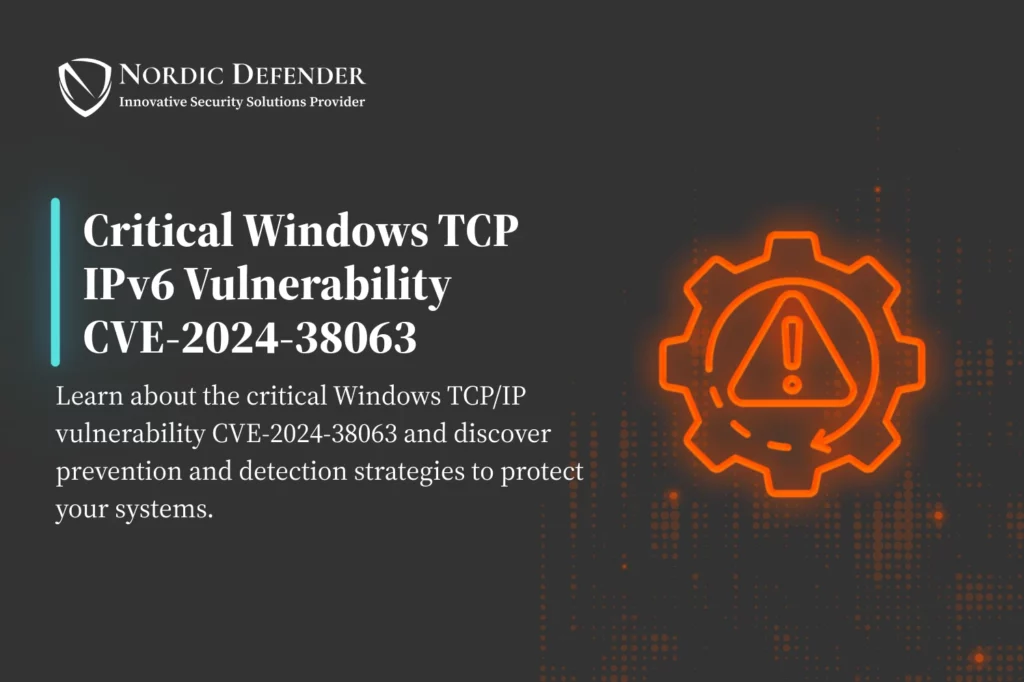In the ever-evolving landscape of cybersecurity, staying ahead of potential threats is paramount. Recently, a critical vulnerability has been discovered in the Windows TCP/IP stack, specifically targeting systems utilizing IPv6. This vulnerability, identified as CVE-2024-38063, has garnered significant attention due to its high severity rating of 9.8 out of 10. In this article, we delve deeper into the nature of this vulnerability, its implications, and the measures organizations can take to safeguard their systems.
Understanding CVE-2024-38063
CVE-2024-38063 is a remote code execution (RCE) vulnerability that exploits the Windows TCP/IP stack. By sending specially crafted IPv6 packets, an attacker can execute arbitrary code on the target system without any user interaction. This makes the vulnerability particularly dangerous, as it can be exploited remotely and silently.
The vulnerability stems from a flaw in the way the Windows TCP/IP stack handles IPv6 packets. When these packets are processed, the flaw allows for memory corruption, which can then be leveraged to execute malicious code. This type of vulnerability is highly sought after by attackers, as it provides a direct pathway to compromise a system.
Systems Affected by CVE-2024-38063
All Windows systems that utilize IPv6 are susceptible to this vulnerability. This includes both client and server versions of Windows, making it a widespread issue that requires immediate attention. Organizations that rely on Windows-based infrastructure must prioritize addressing this vulnerability to prevent potential exploitation.
Exploitation Implications of CVE-2024-38063
The potential impact of CVE-2024-38063 is significant. Successful exploitation can lead to:
- Unauthorized Access: Attackers can gain unauthorized access to sensitive data and systems.
- Data Breach: Compromised systems can result in data breaches, exposing confidential information.
- System Disruption: Malicious code execution can disrupt normal operations, leading to downtime and financial losses.
- Further Exploitation: Once a system is compromised, attackers can use it as a foothold to launch further attacks within the network.
Prevention and Mitigation Strategies for CVE-2024-38063
To mitigate the risks associated with CVE-2024-38063, organizations should implement the following strategies:
Apply Security Patches
Microsoft has released a security update to address this vulnerability. Ensure that all affected systems are updated with the latest patches. Regularly check for updates and apply them promptly to maintain security.
Disable IPv6
If immediate patching is not feasible, consider disabling IPv6 on your systems as a temporary measure. This can be done through the network settings in the control panel or via the command line. However, be aware that disabling IPv6 may impact certain network functionalities.
Enhance Network Monitoring
Implement robust network monitoring solutions to detect any unusual or suspicious activity. Network intrusion detection systems (NIDS) can help identify exploitation attempts by analyzing network traffic for signs of malicious activity.
Strengthen Firewall Rules
Configure your firewall to block unsolicited IPv6 traffic from untrusted sources. This adds an additional layer of protection by preventing potentially malicious packets from reaching your systems.
Conduct Regular Security Audits
Perform regular security audits to identify and address vulnerabilities within your network. This proactive approach helps in maintaining a strong security posture and mitigating potential risks.
Detection Solutions for CVE-2024-38063
Early detection is crucial in mitigating the impact of this vulnerability. Here are some recommended detection solutions:
Intrusion Detection Systems (IDS)
Deploy IDS to monitor network traffic for signs of exploitation attempts. Ensure that your IDS signatures are up-to-date to detect the latest threats. IDS can provide real-time alerts and help in identifying potential breaches.
Log Analysis
Regularly review system and network logs for any anomalies or indicators of compromise. Automated log analysis tools can help in identifying suspicious patterns and potential exploitation attempts. Correlate logs from different sources to gain a comprehensive view of network activity.
Endpoint Protection
Utilize advanced endpoint protection solutions that can detect and block malicious activities on individual devices. Ensure that these solutions are configured to monitor IPv6 traffic. Endpoint protection can provide an additional layer of defense against exploitation attempts.
Conclusion for CVE-2024-38063
The CVE-2024-38063 vulnerability poses a significant threat to Windows systems utilizing IPv6. By taking proactive measures such as applying patches, disabling IPv6, and implementing robust detection solutions, organizations can protect themselves from potential exploitation. It is essential to stay vigilant and ensure that your cybersecurity defenses are up-to-date to safeguard your systems against this critical vulnerability.
For more information and assistance, feel free to contact our cybersecurity experts.
